Multiple Impact Damage in GLARE Laminates: Experiments and Simulations
Abstract
:1. Introduction
2. Experimental Work
2.1. Materials and Specimens
2.2. Impact Test Procedure
3. FE simulation for Multiple Impact
3.1. Development of Finite Element Model
3.2. Development of Damage Progression for Multiple Impact
- Fiber Tension (FT) Failure Mode (ε11 > 0):
- Fiber Compression (FC) Failure Mode (ε11 < 0):
- Matrix Tension/Shear (MT) Failure Mode (ε22 + ε33 > 0):
- Matrix Compression (MC) Failure Mode (ε22 + ε33 < 0):
4. Result and Discussion
4.1. Experimental Results
4.2. Finite Element Simulation on Multiple Impact Behavior of GLARE 5-2/1
4.2.1. Comparison of Experiments and FE Simulation
4.2.2. Two- and Three-Dimensional Failure Criteria Comparison
5. Conclusions
Author Contributions
Funding
Institutional Review Board Statement
Informed Consent Statement
Data Availability Statement
Conflicts of Interest
Nomenclature
| Material stress state | |
| Material strain state | |
| Tensile strain component at failure | |
| Compressive strain component at failure | |
| Hashin fiber tension failure initiation | |
| Hashin fiber compression failure initiation | |
| Hashin matrix tension failure initiation | |
| Hashin matrix compression failure initiation | |
| Composite modulus along the fiber axis | |
| Composite modulus transverse to the fiber axis | |
| Poisson’s ratio for the fiber-matrix direction | |
| Poisson’s ratio for the matrix-matrix direction | |
| Shear modulus fiber-matrix direction | |
| Time value at current finite element analysis increment | |
| Time step between successive increments | |
| Damage propagation rate for each failure mode (i) | |
| Damage state variable for each failure mode (i) | |
| Damage nucleation rate constant | |
| Damage growth rate constant | |
| Material compliance matrix | |
| Material degradation factor | |
| Material stiffness matrix |
References
- Vermeeren, C.A.J.R. An historic overview of the development of fiber metal laminate. Adv. Compos. Mater. 2003, 10, 189–205. [Google Scholar] [CrossRef]
- Krishnakumar, S. Fiber metal laminates-the synthesis of metals and composites. Mater. Manuf. Process 1994, 9, 295–354. [Google Scholar] [CrossRef]
- Vlot, A.; Vogelesang, L.B.; de Vries, T.J. Towards application of fiber metal laminates in larger aircraft. Aircr. Eng. Aerosp. Technol. 1999, 71, 55–57. [Google Scholar] [CrossRef]
- Vogelesang, L.B.; Vlot, A. Development of fibre metal lminates for avanced aerospace materials. J. Mater. Process. Technol. 2000, 103, 1–5. [Google Scholar] [CrossRef]
- Wu, G.; Yang, J.M. The mechanical behavior of GLARE laminates for aircraft structures. Miner. Met. Mater. Ser. 2005, 57, 72–80. [Google Scholar] [CrossRef]
- Wu, G. The Impact Properties and Damage Tolerance and of Bidirectionally Reinforced Fiber Metal Laminates. Miner. Met. Mater. Ser. 2007, 42, 948–957. [Google Scholar]
- Cantwell, W.J.; Morton, J. The impact resistance of composite materials—A review. Compos. Part A Appl. Sci. Manuf. 1991, 22, 347–362. [Google Scholar] [CrossRef]
- Rotem, A. The strength of laminated composite materials under repeated impact loading. Compos. Sci. Technol. 1988, 10, 19–27. [Google Scholar]
- Harris, B.; Chen, A.S.; Coleman, S.L.; Moore, R.J. Residual strength and toughness of damaged. Composites. J. Mater. Sci. 1991, 26, 307–320. [Google Scholar] [CrossRef]
- Shi, Y.; Swait, T.; Soutis, C. Modeling damage evolution in composite laminates subjected to low velocity impact. Compos. Struct. 2012, 94, 2902–2913. [Google Scholar] [CrossRef]
- Amouzou, A.S.E.; Sicot, O.; Chettah, A.; Aivazzadeh, S. Experimental characterization of composite laminates under low-velocity multi-impact loading. J. Compos. Mater. 2019, 53, 2391–2405. [Google Scholar] [CrossRef]
- Amaro, A.M.; Reis, P.N.B.; de Moura, M.F.S.F.; Neto, M.A. Influence of multi-impacts on GFRP composites laminates. Compos. B Eng. 2013, 52, 93–99. [Google Scholar] [CrossRef]
- Found, M.S.; Howard, I.C. Single and multiple impact behavior of a CFRP laminate. Compos. Struct. 1995, 32, 159–163. [Google Scholar] [CrossRef]
- Moriniere, F.D.; Alderliesten, R.C.; Yarmohammad Tooski, M.; Benedictus, R. Damage evolution in GLARE fibre-metal laminate under repeated low-velocity impact tests. Cent. Eur. J. Eng. 2012, 2, 603–611. [Google Scholar] [CrossRef]
- Rajkumar, G.R.; Krishna, M.; Murthy, H.N.N.; Sharma, S.C.; Mahesh, K.R.V. Experimental investigation of low-velocity repeated impact on glass fiber metal composites. J. Mater. Eng. Perform. 2012, 21, 1485–1490. [Google Scholar] [CrossRef]
- Yao, L.; Sun, G.; He, W.; Meng, X.; Xie, D. Investigation on impact behavior of FMLs under multiple impacts with the same energy: Experimental characterization and numerical simulation. Compos. Struct. 2019, 226, 111218. [Google Scholar] [CrossRef]
- Hashin, Z. Failure criteria for unidirectional fiber composites. J. Appl. Mech. 1980, 47, 329–335. [Google Scholar] [CrossRef]
- Seo, H.S.; Hundley, J.; Hahn, H.T.; Yang, J.M. Numerical simulation of glass-fiber-reinforced aluminum laminates with diverse impact damage. AIAA J. 2010, 48, 676–687. [Google Scholar] [CrossRef]
- Yu, G.; Wu, L.; Ma, L.; Xiong, J. Low velocity impact of carbon fiber aluminum laminates. Compos. Struct. 2015, 119, 757–766. [Google Scholar] [CrossRef]
- Mittelman, A. Low-energy repetitive impact in carbon-epoxy composites. J. Mater. Sci Technol. 1992, 27, 2458–2462. [Google Scholar] [CrossRef]
- Linde, P.; Pleitner, J.; De Boer, H.; Carmone, C. Modeling and simulation of fiber metal laminates. In Proceedings of the ABAQUS User’s Conference, Boston, MA, USA, 25–27 May 2004. [Google Scholar]
- Tsai, S.W.; Wu, E.M. General theory of strength for anisotropic materials. J. Compos. Mater. 1971, 5, 58–80. [Google Scholar] [CrossRef]
- Hashin, Z.; Rotem, A. A fatigue failure criterion for fiber reinforced materials. J. Compos. Mater. 1973, 7, 448–464. [Google Scholar] [CrossRef] [Green Version]
- Hou, J.P.; Petrinic, N.; Ruiz, C.; Hallett, S.R. Prediction of impact damage in composite plates. Compos. Sci. Technol. 2000, 60, 273–281. [Google Scholar] [CrossRef]
- Puck, A.; Schürmann, H. Failure analysis of FRP laminates by means of physically based phenomenological methods. Compos. Sci. Technol. 2002, 62, 1633–1662. [Google Scholar] [CrossRef]
- Santiuste, C.; Sánchez-Sáez, S.; Barbero, E. A comparison of progressive-failure criteria in the prediction of the dynamic bending failure of composite laminated beams. Compos. Struct. 2010, 92, 2406–2414. [Google Scholar] [CrossRef] [Green Version]
- Li, X.; Ma, D.; Liu, H.; Tan, W.; Gong, X.; Zhang, C.; Li, Y. Assessment of failure criteria and damage evolution methods for composite laminates under low velocity impact. Compos. Struct. 2019, 207, 727–739. [Google Scholar] [CrossRef]
- Smith, M. ABAQUS/Standard User’s Manual, Version 6.14; Dassault Systemes Simulia Corp.: Johnston, RI, USA, 2014. [Google Scholar]
- Matzenmiller, A.; Lubliner, J.; Taylor, R.L. A constitutive model for anisotropic damage in fiber composites. Mech. Mater. 1995, 20, 125–152. [Google Scholar] [CrossRef]
- Iannucci, L.; Dechaene, R.; Willows, M.; Degrieck, J. A failure model for the analysis of thin woven glass composite structures under impact loadings. Comput. Struct. 2001, 79, 785–799. [Google Scholar] [CrossRef]
- Nguyen, M.Q.; Elder, D.J.; Bayandor, J.; Thomson, R.S.; Scott, M.L. A review of explicit finite element software for composite impact analysis. J. Compos. Mater. 2005, 39, 375–386. [Google Scholar] [CrossRef]
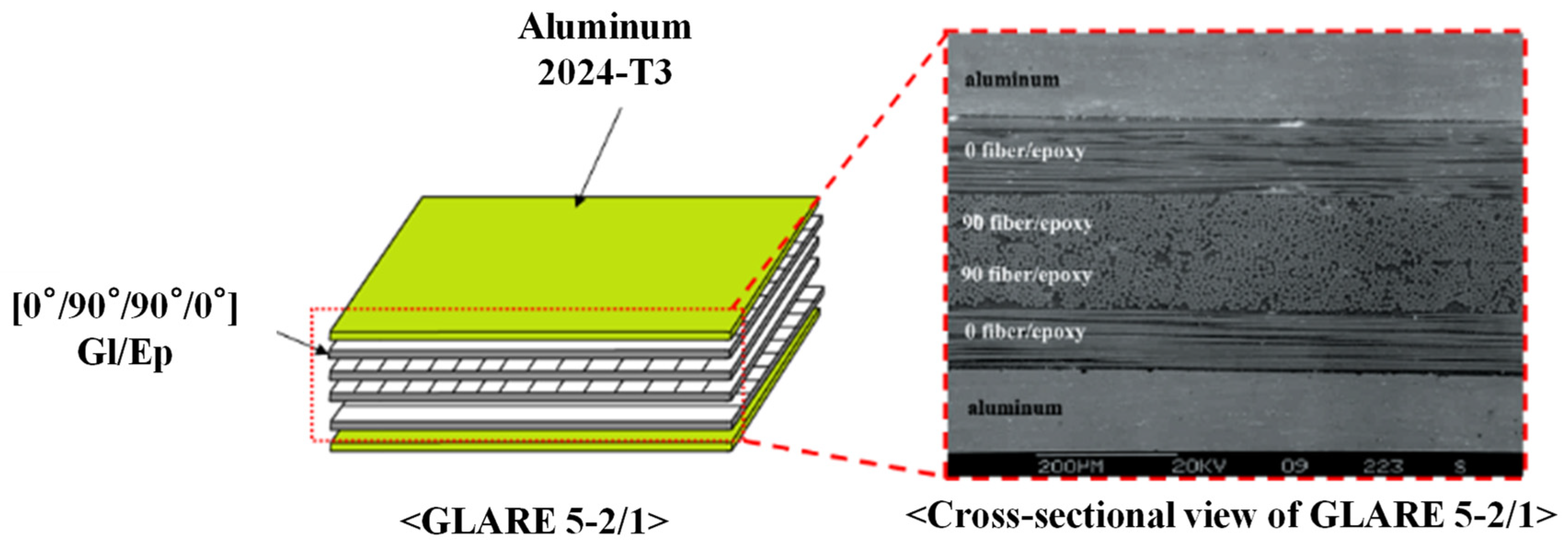

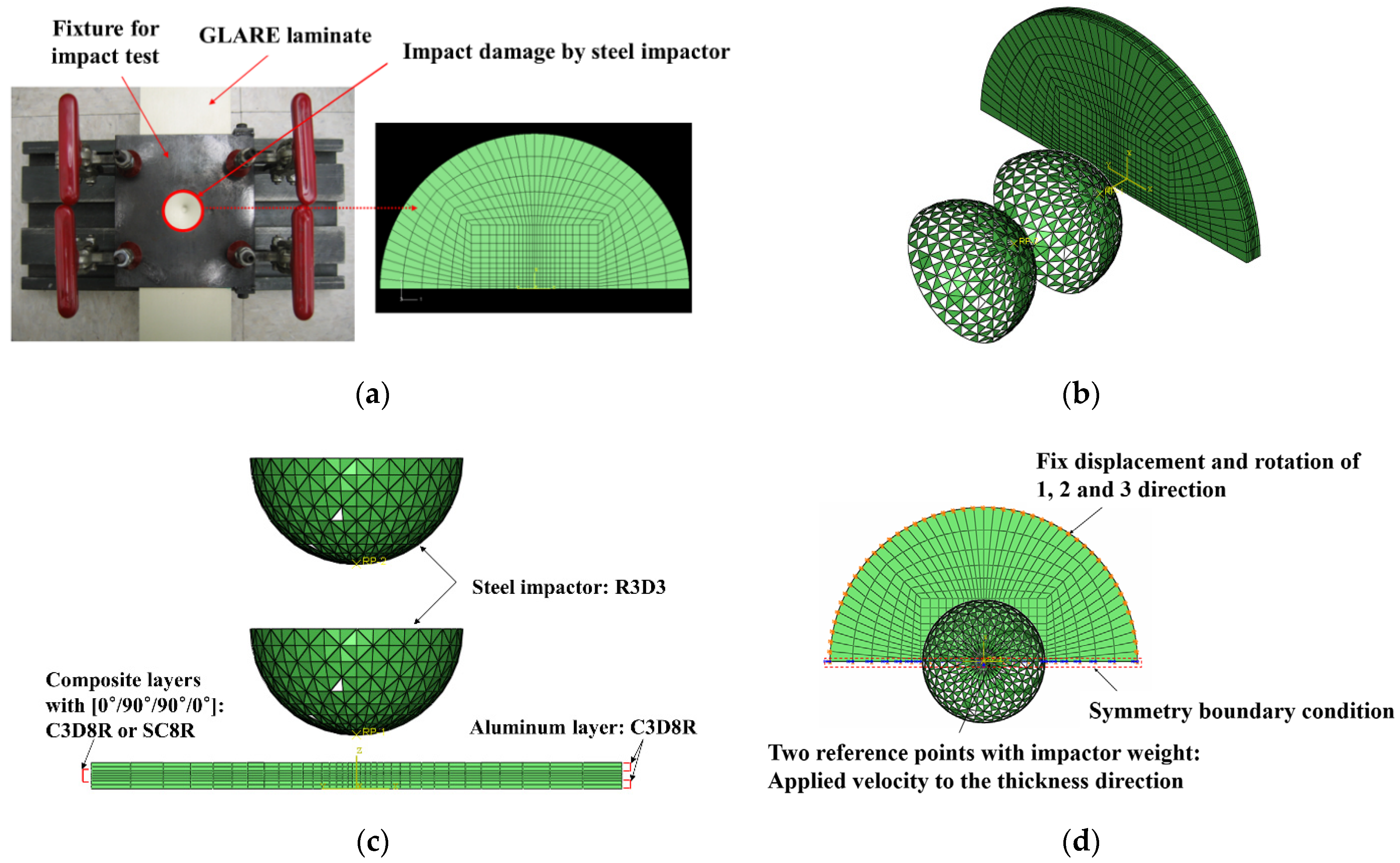
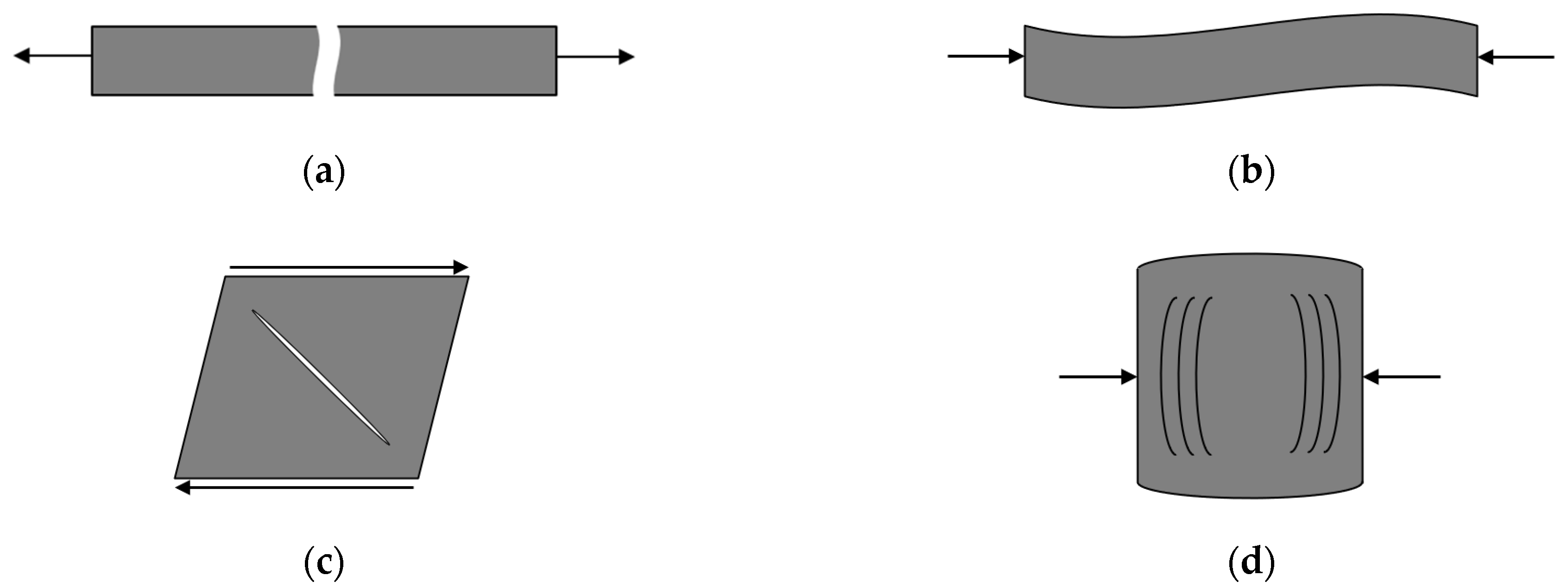



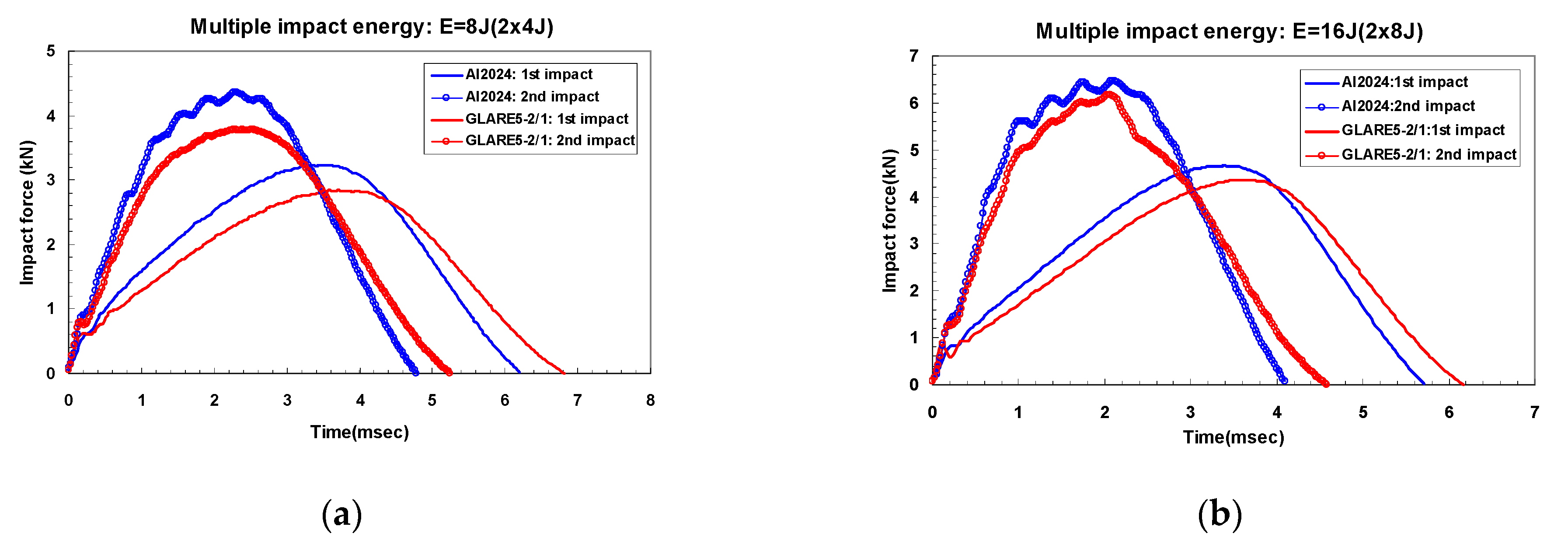
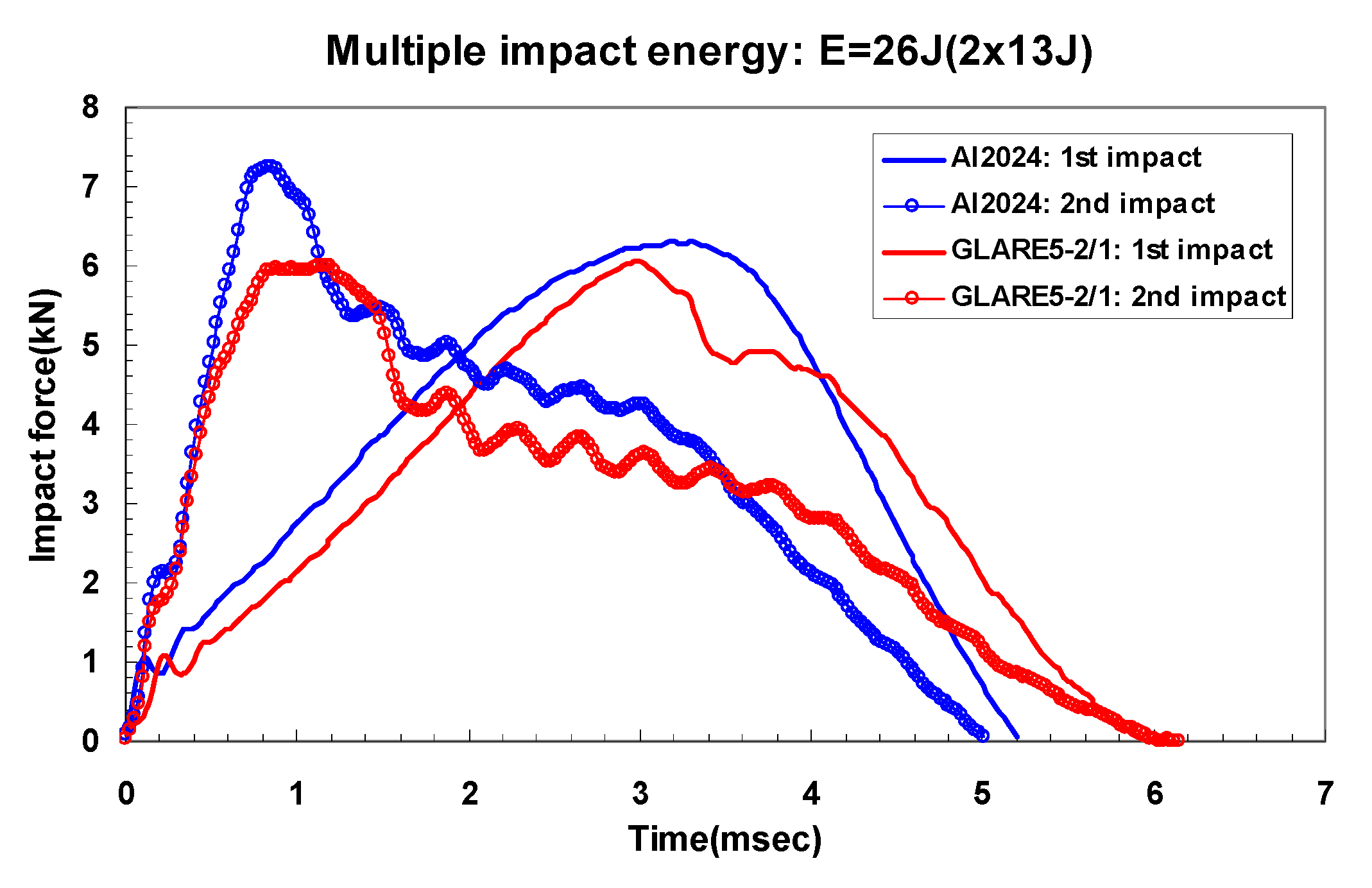
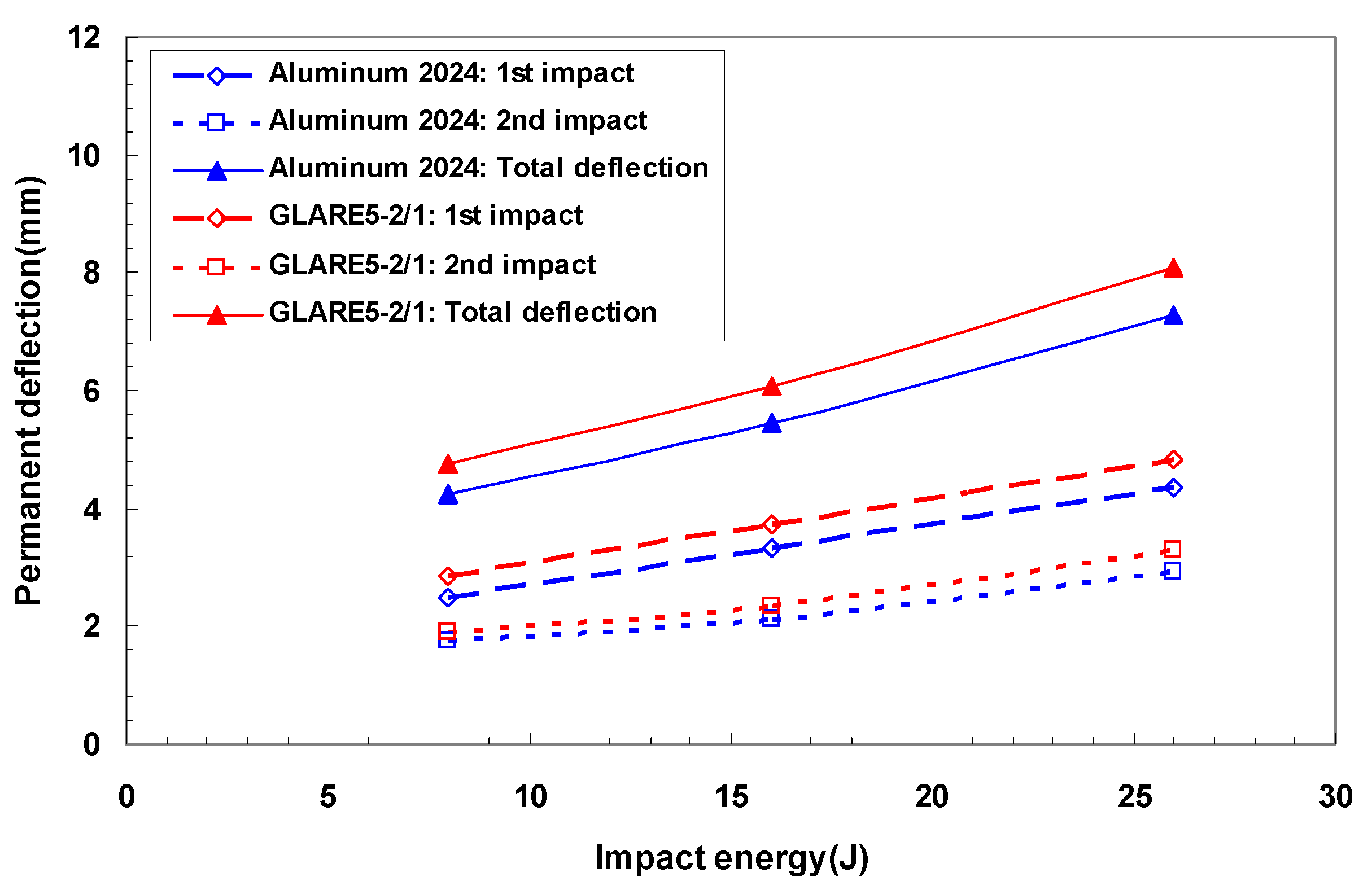
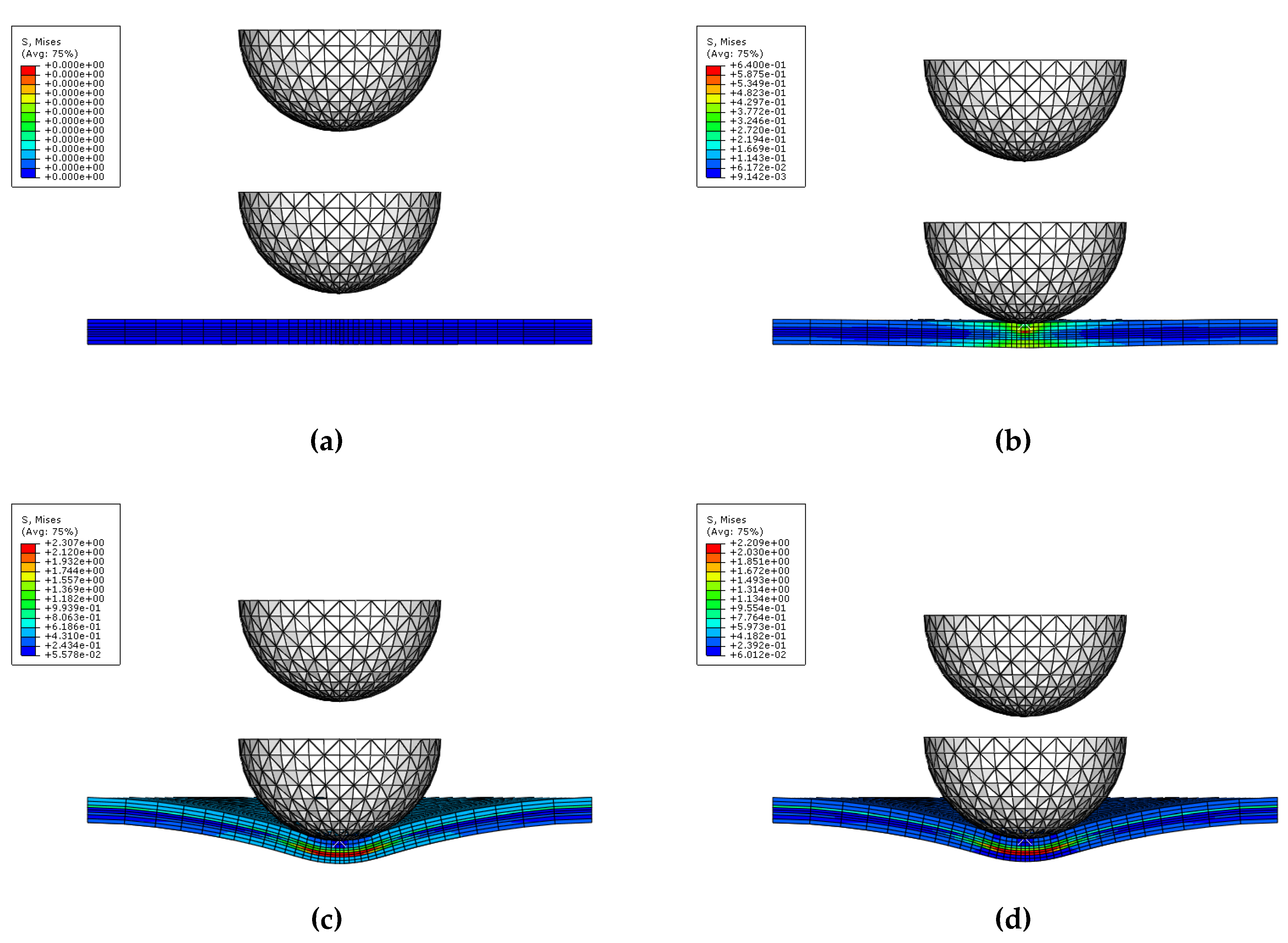
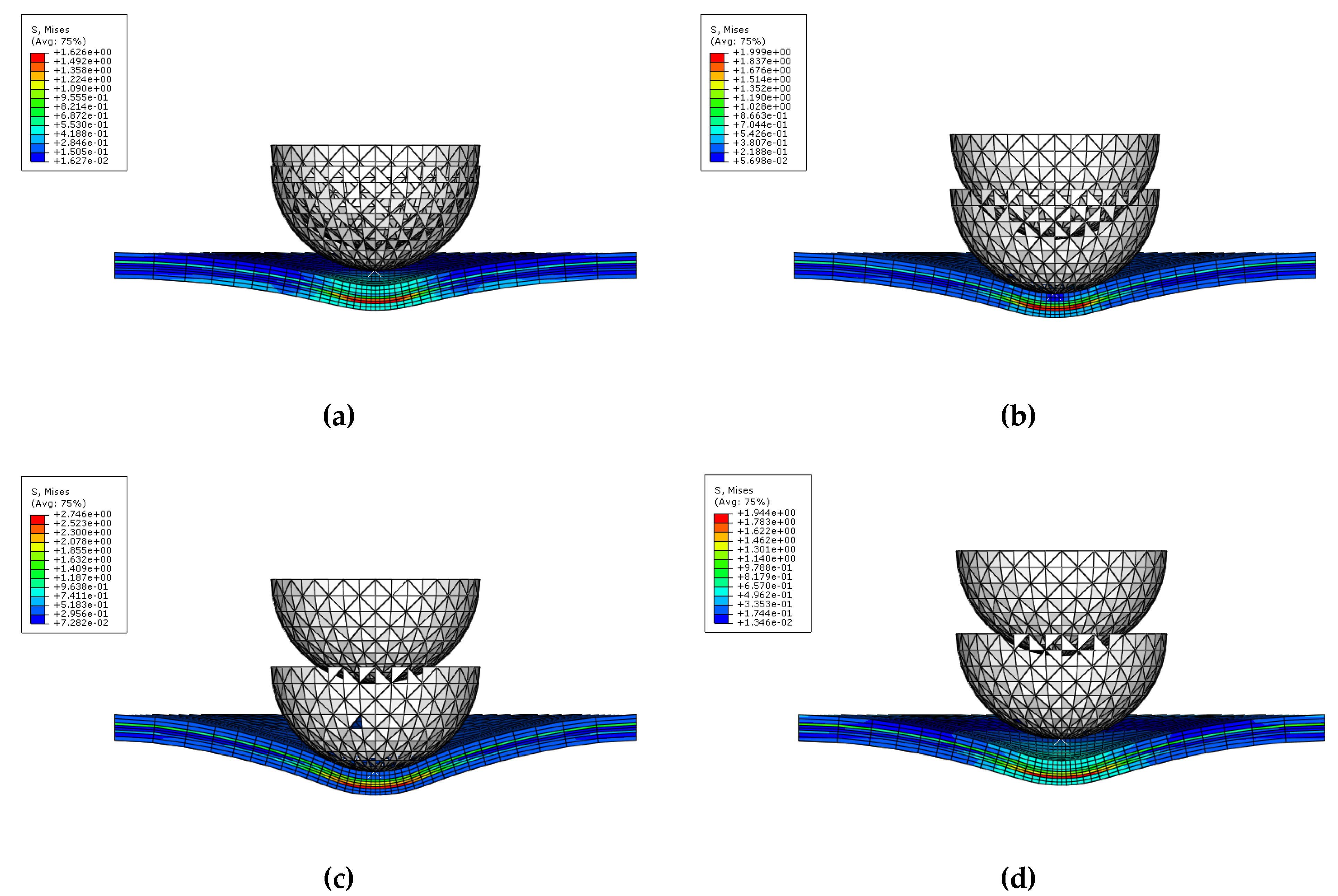
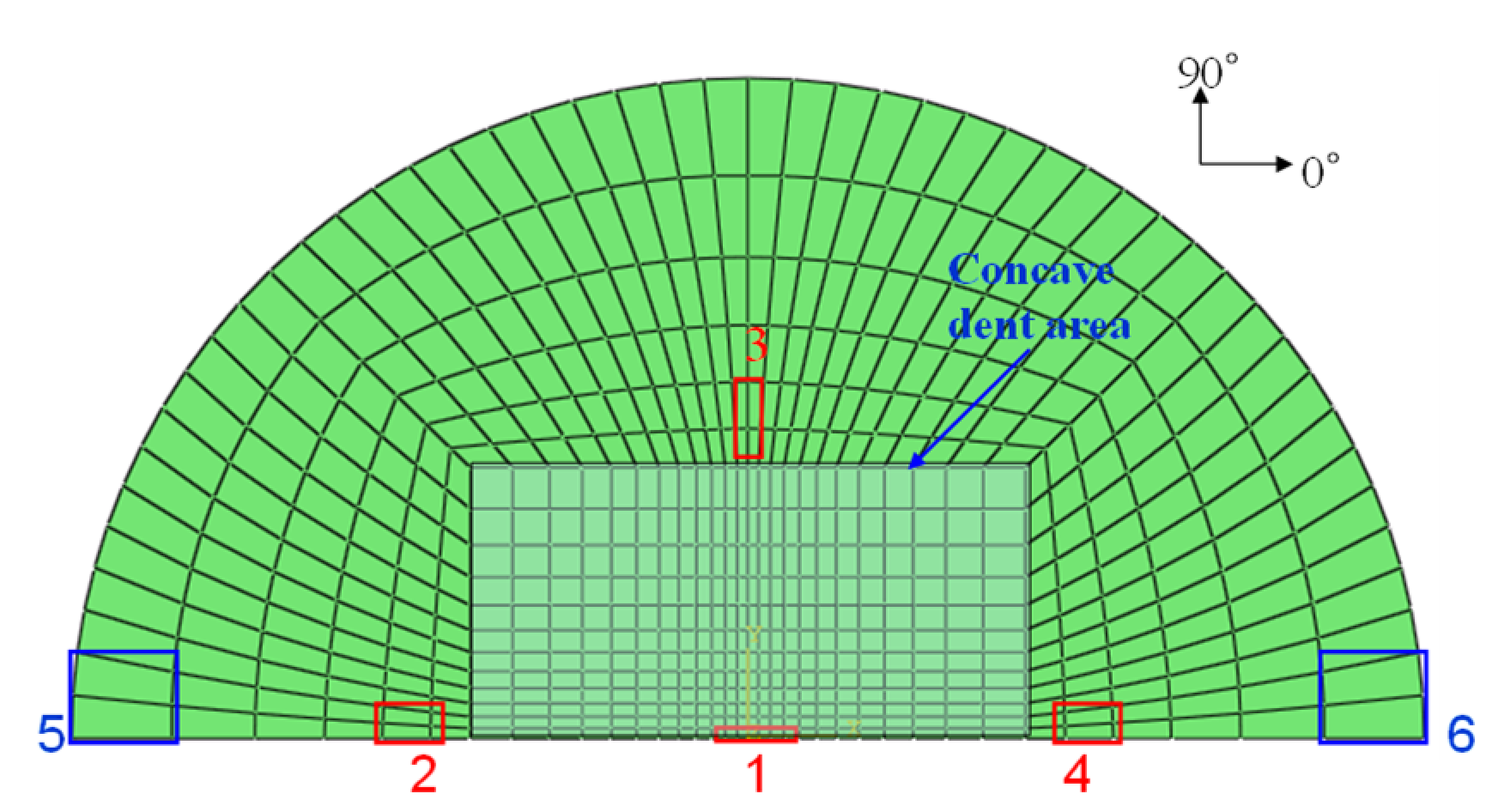


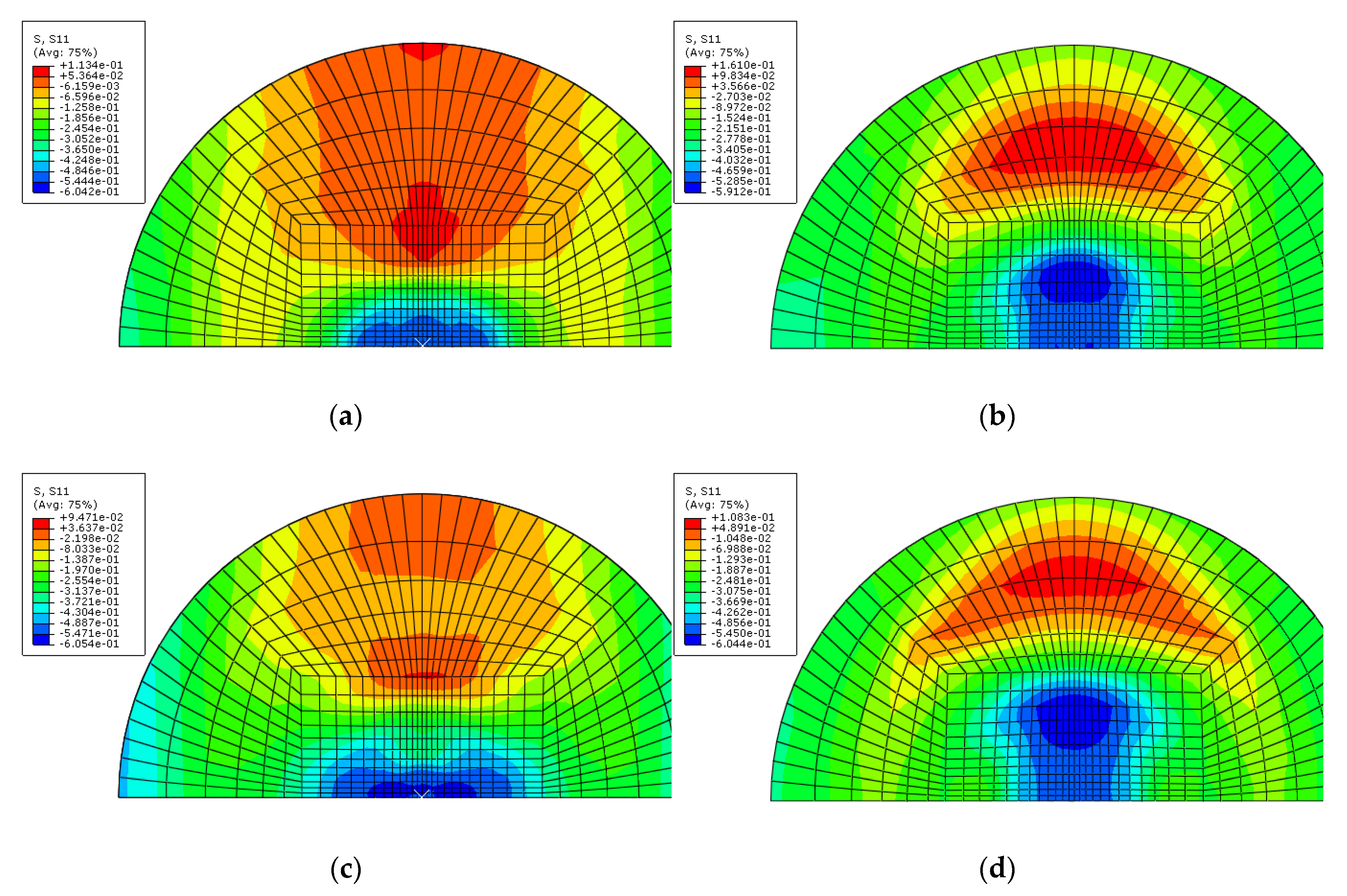



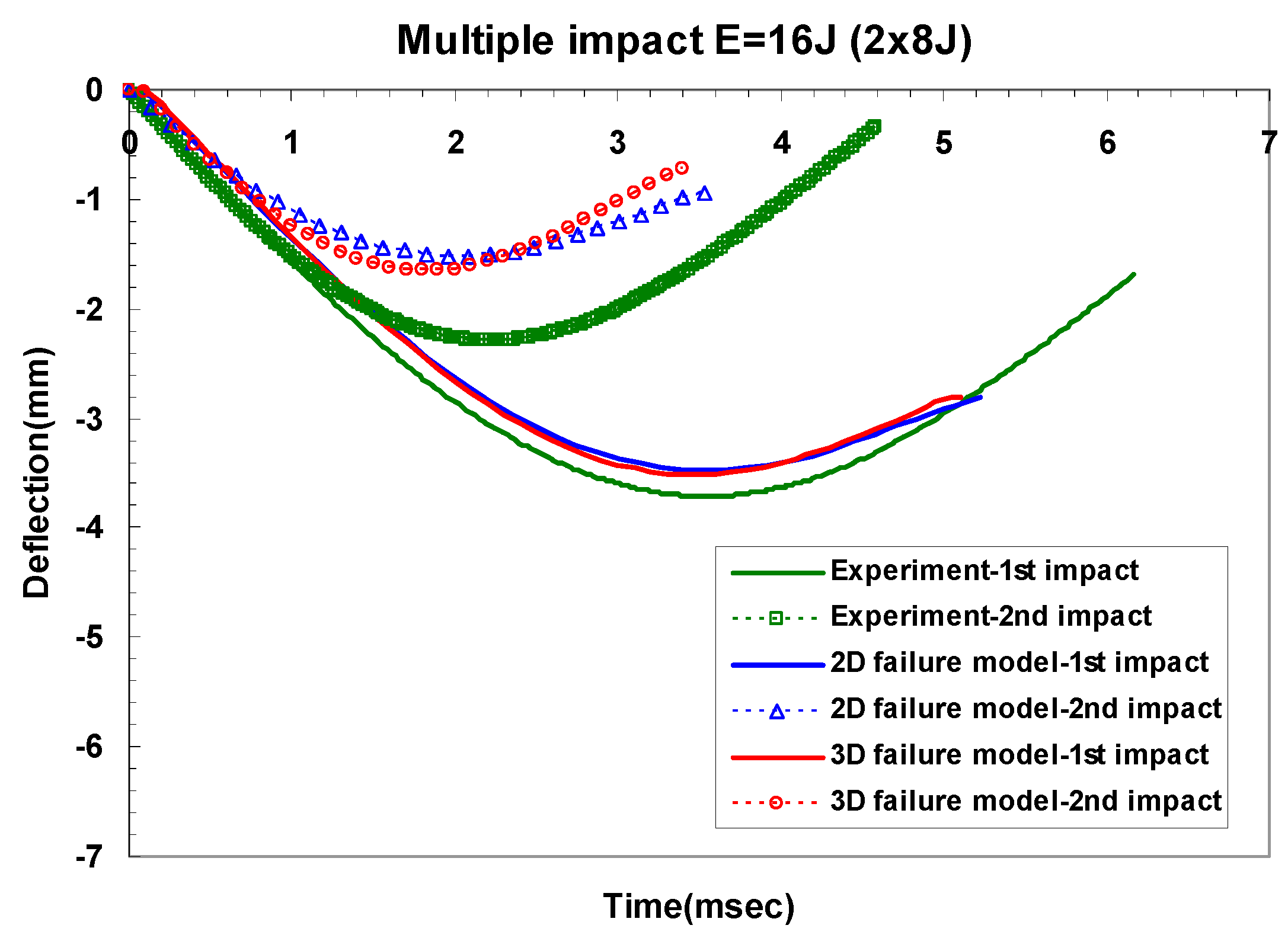
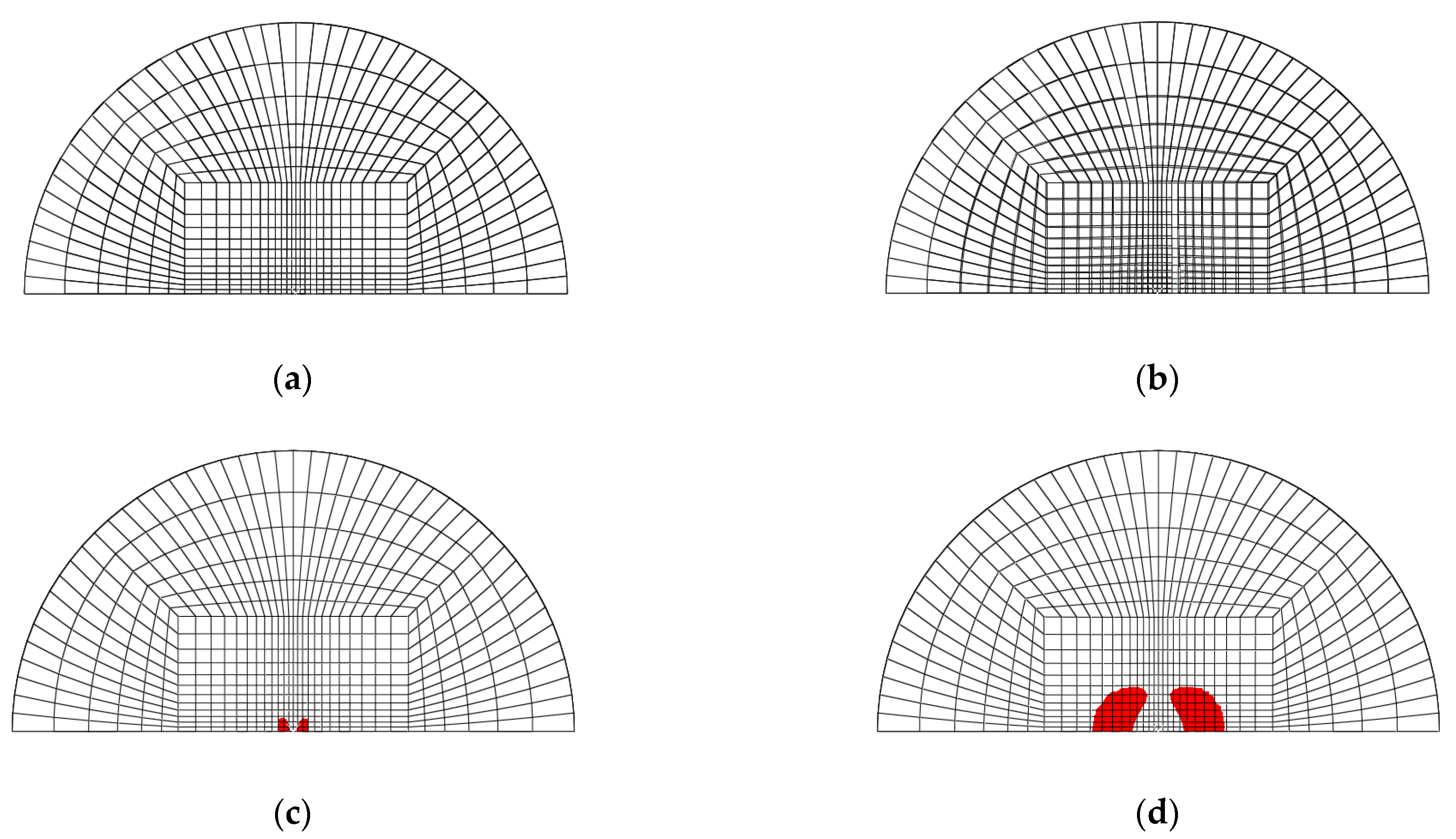



| Material | Parameter Values, GPa | |||||
|---|---|---|---|---|---|---|
| E11 | E22 | G12 | G23 | ν12 | ν23 | |
| Al 2024-T3 | 72.2 | 72.2 | - | - | 0.33 | 0.33 |
| S2 glass | 55 | 9.5 | 5.5 | 3 | 0.33 | 0.33 |
| Material | Parameter Values, MPa | |||||
|---|---|---|---|---|---|---|
| σys | Xt | Xc | Yt | Yc | Slt | |
| Al 2024-T3 | 320 | - | - | - | - | - |
| S2 glass | - | 2500 | 2000 | 50 | 150 | 75 |
| Failure Mode | Degraded Elastic Material Properties | ||||
|---|---|---|---|---|---|
| E11 | E22 | ν12 | ν23 | G12 | |
| Fiber tension (FT) | Χ | — | Χ | — | Χ |
| Fiber compression (FC) | Χ | — | Χ | — | Χ |
| Matrix tension/shear (MT) | — | Χ | Χ | Χ | Χ |
| Matrix compression (MC) | — | Χ | Χ | Χ | Χ |
| Materials | Thickness (mm) | Areal Density (kg/m2) | Minimum Cracking Energy (J) | Perforation Energy (J) |
|---|---|---|---|---|
| Aluminum 2024-T3 | 1.60 | 4.45 | 18.1 | 33.4 |
| GLARE 5-2/1 | 1.56 | 3.74 | 16.3 | 34.5 |
| Location | Stress (MPa) | |||
|---|---|---|---|---|
| 8 J (Impacted) | 8 J (Non-Impacted) | 16 J (Impacted) | 16 J (Non-Impacted) | |
| 1 | 515 | 531 | 531 | 532 |
| 2 | 140 | 254 | 328 | 226 |
| 3 | 137 | 252 | 320 | 242 |
| 4 | 141 | 248 | 329 | 224 |
| 5 | 343 | 268 | 307 | 307 |
| 6 | 344 | 266 | 303 | 303 |
| Location | Stress (MPa) | |||
|---|---|---|---|---|
| 8 J (Impacted) | 8 J (Non-Impacted) | 16 J (Impacted) | 16 J (Non-Impacted) | |
| 1 | −528 | −522 | −548 | −518 |
| 2 | −111 | −228 | −303 | −227 |
| 3 | 56 | 10 | −4 | −146 |
| 4 | −112 | −223 | −309 | −223 |
| 5 | −290 | −288 | −398 | −305 |
| 6 | −292 | −286 | −397 | −299 |
| Impact Energy | Differences of Peak Impact Force (%) | |||
|---|---|---|---|---|
| 2D Failure Model | 3D Failure Model | |||
| First Impact | Second Impact | First Impact | Second Impact | |
| 8 J | 1.41 | 11.1 | 4.58 | 20.37 |
| 16 J | 2.75 | 1.00 | 8.02 | 16.14 |
| Impact Energy | Differences of Maximum Dent Depth (%) | |||
|---|---|---|---|---|
| 2D Failure Model | 3D Failure Model | |||
| First Impact | Second Impact | First Impact | Second Impact | |
| 8 J | 6.69 | 30.0 | 5.63 | 26.8 |
| 16 J | 7.47 | 34.8 | 6.40 | 29.2 |
Publisher’s Note: MDPI stays neutral with regard to jurisdictional claims in published maps and institutional affiliations. |
© 2021 by the authors. Licensee MDPI, Basel, Switzerland. This article is an open access article distributed under the terms and conditions of the Creative Commons Attribution (CC BY) license (https://creativecommons.org/licenses/by/4.0/).
Share and Cite
Lee, S.-E.; Kim, D.-U.; Cho, Y.-J.; Seo, H.-S. Multiple Impact Damage in GLARE Laminates: Experiments and Simulations. Materials 2021, 14, 7800. https://doi.org/10.3390/ma14247800
Lee S-E, Kim D-U, Cho Y-J, Seo H-S. Multiple Impact Damage in GLARE Laminates: Experiments and Simulations. Materials. 2021; 14(24):7800. https://doi.org/10.3390/ma14247800
Chicago/Turabian StyleLee, Sang-Eui, Dong-Uk Kim, Yong-Jun Cho, and Hyoung-Seock Seo. 2021. "Multiple Impact Damage in GLARE Laminates: Experiments and Simulations" Materials 14, no. 24: 7800. https://doi.org/10.3390/ma14247800
APA StyleLee, S.-E., Kim, D.-U., Cho, Y.-J., & Seo, H.-S. (2021). Multiple Impact Damage in GLARE Laminates: Experiments and Simulations. Materials, 14(24), 7800. https://doi.org/10.3390/ma14247800






